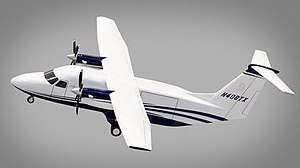Cessna 408 SkyCourier
The Cessna 408 SkyCourier is an American twin-turboprop, high-wing, utility aircraft under development by Textron Aviation.
| Cessna 408 SkyCourier | |
|---|---|
 | |
| Cessna 408 SkyCourier model shown at EBACE 2018 | |
| Role | Twin Turboprop aircraft |
| National origin | United States |
| Manufacturer | Textron Aviation |
| First flight | May 17, 2020[1] |
| Introduction | 2020 (initially planned)[2] |
| Status | Under development |
| Number built | 2 prototypes[3] |
| Unit cost |
$5.5 million[4] |
Development
The Model 408 was launched on November 28, 2017 by Textron Aviation, with an introduction planned for 2020.[2] The 408's design was developed to match FedEx Express requirements, like the earlier Cessna 208 Caravan.[5] FedEx Express will be the launch customer, with an order of "50 cargo aircraft and options for 50 more".[2][6]
Initial wind tunnel tests were completed in March 2018. The first flight was originally planned for 2019 and first deliveries anticipated in 2020.[7] The design will be certified to FAR Part 23 standards.[8] FedEx plans to take monthly deliveries over four years starting in 2020, and a similar pace for a second batch, if it agrees to that option.[9] A full-scale mockup of the 19-passenger cabin was displayed at the October 2018 National Business Aviation Association convention.[10]
The mating of the wing and fuselage of the first aircraft was completed in December 2019.[11]
By March 2020, initial ground testing was completed, checking the fuel system, engines, avionics interfaces and electrical systems.[12] The first flight was completed on May 17, 2020, operating from Beech Factory Airport for a 2-hour and 15-minute flight. The prototype aircraft, along with five additional flight and ground test articles, will be used for testing leading to certification.[1] The second prototype first flew in August 2020. It is the first production-conforming aircraft and will be used for testing the engines, propellers, environmental controls and the avionics.[3]
Design
The SkyCourier is a twin-turboprop, high-wing, utility aircraft. It will be available in a 19-passenger variant with large cabin windows and separate crew and passenger doors, or in a cargo variant sized for three LD3s and 6,000 pounds of payload, featuring a "large cargo door and a flat floor cabin". It will cruise up to 200 kn (370 km/h), with a maximum range of 900 nmi (1,700 km). Single-point refueling will speed turnarounds.[2]
The clean-sheet design should offer better cabin flexibility and payload capability, superior performance and lower operating costs than its competitors.[2] The airframe will be built from traditional aluminum materials and will be equipped with proven Pratt & Whitney Canada PT6A-65 engines, fixed landing gear and Garmin G1000 avionics. The non-pressurized cabin will be 70 in (178 cm) tall and wide, with a flat floor and a 87 in (221 cm) cargo door.[8]
Specifications
Data from Cessna[13]
General characteristics
- Capacity: 19 passengers/5,000 lb (2,268 kg) payload (commuter) or 3×LD3s/6,000 lb (2,722 kg) payload (cargo)
- Length: 54 ft 10 in (16.71 m)
- Wingspan: 72 ft 0 in (21.95 m)
- Height: 19 ft 9 in (6.02 m)
- Powerplant: 2 × Pratt & Whitney Canada PT6A-65SC turboprop, 1,100 hp (820 kW) each
- Propellers: 4-bladed McCauley
Performance
- Cruise speed: 230 mph (370 km/h, 200 kn) maximum
- Range: 460 mi (740 km, 400 nmi) Cargo Range (with 5,000 lb payload)
- Ferry range: 1,000 mi (1,700 km, 900 nmi)
- Service ceiling: 25,000 ft (7,600 m)
- Takeoff Distance : 3,300 ft (1,006 m)
See also
Aircraft of comparable role, configuration and era
- Aircraft Industries L 410 NG
- Viking DHC-6-400 Twin Otter
- Dornier Do 228NG
- Harbin Y-12F
- Indonesian Aerospace N-219
- PZL M28 Skytruck
References
- "First Cessna SkyCourier twin utility turboprop takes flight" (Press release). Textron Aviation. May 17, 2020. Archived from the original on May 18, 2020.
- "Textron Aviation unveils new large-utility turboprop, the Cessna SkyCourier; FedEx Express signs as launch customer for up to 100 aircraft" (Press release). Textron Aviation Inc. November 28, 2017.
- Cook, Marc (August 11, 2020). "Testing, Testing: Second Cessna SkyCourier Flies". AVweb. Archived from the original on August 12, 2020. Retrieved August 12, 2020.
- Molly McMillin (November 28, 2017). "Textron Launches New SkyCourier Turboprop With Cargo, Pax Versions". Aviation Week Network.
- Bertorelli, Paul (November 30, 2017). "Cessna And FedEx Renew Their Vows". AVweb. Retrieved December 15, 2017.
- "FedEx to be launch customer for new Cessna turboprop". Air Cargo News. November 28, 2017. Archived from the original on October 15, 2019. Retrieved October 15, 2019.
- Grady, Mary (March 13, 2018). "Textron Reports On SkyCourier Progress". AVweb. Retrieved March 14, 2018.
- Kerry Lynch (November 28, 2017). "Textron Launches Cessna SkyCourier with 100-Plane Deal". AIN.
- Stephen Trimble (November 28, 2017). "Textron launches Beech 1900-sized SkyCourier with FedEx order". Flightglobal.
- James Wynbrandt (October 17, 2018). "Textron Debuts SkyCourier Mockup in Pax Config". AIN.
- "Textron Aviation marks successful wing and fuselage mate of the first Cessna SkyCourier aircraft; begins next phase in development" (Press release). Textron Aviation. December 19, 2019.
- Kate Sarsfield (March 23, 2020). "SkyCourier completes initial ground testing". flightglobal.
- "SkyCourier". Cessna.